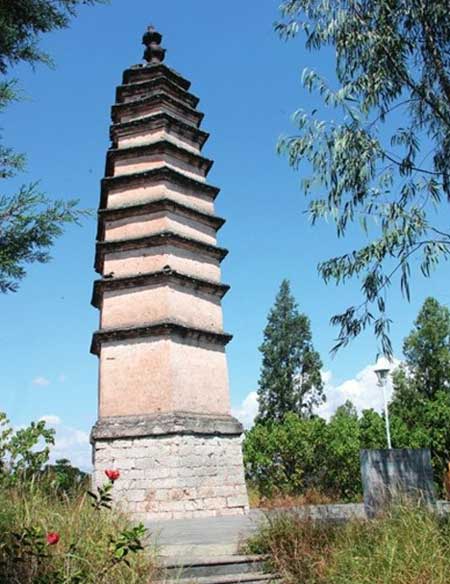Wenbi Pagoda in Midu County, Dali
On August 19th of the 12th year of the Chongzhen reign (1639), the renowned traveler Xu Xiake (徐霞客) departed from Menghua (蒙化, now known as Weishan 巍山), passed through Longqing Pass (隆庆关), and entered Midu (弥渡). On that sunny autumn afternoon, the first sight that caught his eye was the imposing Wenbi Tower (文笔塔), standing tall east of the county town. After walking about one li around Mount Wenbi (文笔山), he stayed overnight in the village of Shanghai Zi (上海子村). That evening, under the dim light of a flickering lamp, he wrote in his travel journal:
“Bought rice in the town, exited through the north gate, turned east along the wall for one li. A ridge winds from the southeast to the north, with a small pagoda atop it.”
The “small pagoda” Xu described is the Wenbi Tower (文笔塔) that still stands today in its original form.
Architectural Features
Situated atop Mount Huilong (回龙山), Wenbi Tower is also locally known as Huilong Tower (回龙塔). The structure is approximately 16 meters tall, built in the solid hexagonal 密檐式 (dense eaves) brick pagoda style. It consists of eleven levels, each built with staggered floral-edged grey bricks that create a tooth-like pattern—both firm and simple in design. The tower is coated in white lime plaster, leading to its being referred to as the White Pagoda (白塔) in the Zhaozhou Gazetteer (万历《赵州志》).
The top finial is made of cast iron, now rusted and weathered. An inscription on the tower’s pinnacle reads: “Eternally Suppressing the Mountain Ghosts” (永镇大尸山鬼), suggesting its purpose as both a cultural and spiritual symbol—to ward off disease and promote scholarly prosperity.
Although no exact date of construction appears in historical records, it is widely accepted that the tower was built during the Wanli reign (1573–1620) of the Ming Dynasty, giving it a history of over 400 years. A legend cited in the Zhaozhou Gazetteer from the Qianlong era claims that the tower was built by a son of Emperor Ashoka, but this is considered implausible.
Symbolic Meaning and Feng Shui Significance
Wenbi Tower symbolizes the scholarly spirit and literary tradition of Midu (弥渡). According to local legend, during the Wanli reign, scholars and gentry observed that Mount Huilong (回龙山) stood on the eastern ridge, while the Bixiong River (毗雄河) flowed southward. Since the county lies higher in the north and lower in the south, it was believed that the area’s spiritual energy (元气) was dispersing.
To “tie the boat of Midu” (弥城若舟,建塔以绾之), they erected the tower to enhance the local feng shui, amplify scholarly spirit, and pray for the flourishing of education and the success of candidates in the imperial exams. It was also seen as a merger of Buddhist reverence with worldly aspirations for fame and honor.
Feng shui masters predicted that the erection of the tower would consolidate the spiritual energy of Midu, leading to an era of great talent and prosperity. Indeed, the Wenbi Tower, like a giant pen piercing the sky, became a beacon of culture and education. During the late Ming and early Qing, Midu experienced a literary renaissance known as the “Six Imperial Scholars and Six Provincial Graduates” (六科六解亚), marking a peak in local talent development. Midu’s cultural influence rivaled that of the prefectural capital.
Cultural Expansion and Educational Revival
Historical records show that building towers to regulate feng shui and promote literary success was a common tradition in Midu. In addition to Wenbi Tower, in the first year of the Jiaqing reign (1796) of the Qing Dynasty, a local magistrate surnamed Lu (陆) led the construction of Huilong Temple (回龙祠) atop Mount Huilong (回龙山). Temples such as the Dragon King Temple (龙王庙) were also built at the mountain’s base as places for officials and citizens to pray for favorable weather.
During the Daoguang period, literary achievements had declined compared to the previous golden age. Chen Tao (陈焘), then magistrate of Dali stationed in Midu, believed that the Kui Guang Academy (奎光书院), located at the base of Mount Qingluo (青螺山), suffered from poor feng shui due to its low-lying position near the city moat.
In response, he donated funds to expand the Huilong Temple, adding four new rooms and establishing the Longwen Academy (龙文书院). From then on, the area beneath Wenbi Tower echoed with the sound of reading, revitalizing the literary spirit of the region.
In the 13th year of the Guangxu reign (1887), Cen Yuying (岑毓英), Governor-General of Yunnan and Guizhou, personally inscribed the plaque for the Wenxian Pavilion (文献楼) with the phrase “A Land of Literary Heritage” (文献名邦), and wrote a couplet:
“The land promotes harmony; the people value courtesy.
Talents rise from humble roots, and excellence flows from scholars.”
To this day, Midu No.1 High School (弥渡一中) is located beneath the tower, where generations of students continue to study diligently.
Legacy and Cultural Appreciation
Over centuries, Wenbi Tower has endured natural disasters, wars, fires, and multiple strong earthquakes. Yet, it still stands with solemn majesty, guarding and purifying the land of Midu (弥渡). Historically, it was known as Huilong Tower (回龙塔) until later literati began referring to it as Wenbi Tower (文笔塔), imbuing it with the auspicious meaning of literary prosperity and scholarly excellence.
At the foot of Mount Huilong (回龙山) lies a clear pool of water. On clear, moonlit nights, the tower’s reflection appears in the water, a scene admired by scholars who named it “Wenbi Adds Inkstone” (文笔添砚), recognizing it as one of the Ten Scenic Spots of Midu (弥渡十景). This tradition likely dates back to the late Qing Dynasty.

 7 Days GolfingTour
7 Days GolfingTour
 8 Days Group Tour
8 Days Group Tour
 8 Days Yunnan Tour
8 Days Yunnan Tour
 7 Days Shangri La Hiking
7 Days Shangri La Hiking
 11 Days Yunnan Tour
11 Days Yunnan Tour
 6 Days Yuanyang Terraces
6 Days Yuanyang Terraces
 11 Days Yunnan Tour
11 Days Yunnan Tour
 8 Days South Yunnan
8 Days South Yunnan
 7 Days Tea Tour
7 Days Tea Tour
 8 Days Muslim Tour
8 Days Muslim Tour
 12 Days Self-Driving
12 Days Self-Driving
 4 Days Haba Climbing
4 Days Haba Climbing
 Tiger Leaping Gorge
Tiger Leaping Gorge
 Stone Forest
Stone Forest
 Yunnan-Tibet
Yunnan-Tibet
 Hani Rice Terraces
Hani Rice Terraces
 Kunming
Kunming
 Lijiang
Lijiang
 Shangri-la
Shangri-la
 Dali
Dali
 XishuangBanna
XishuangBanna
 Honghe
Honghe
 Kunming
Kunming
 Lijiang
Lijiang
 Shangri-la
Shangri-la
 Yuanyang Rice Terraces
Yuanyang Rice Terraces
 Nujiang
Nujiang
 XishuangBanna
XishuangBanna
 Spring City Golf
Spring City Golf
 Snow Mountain Golf
Snow Mountain Golf
 Stone Mountain Golf
Stone Mountain Golf















